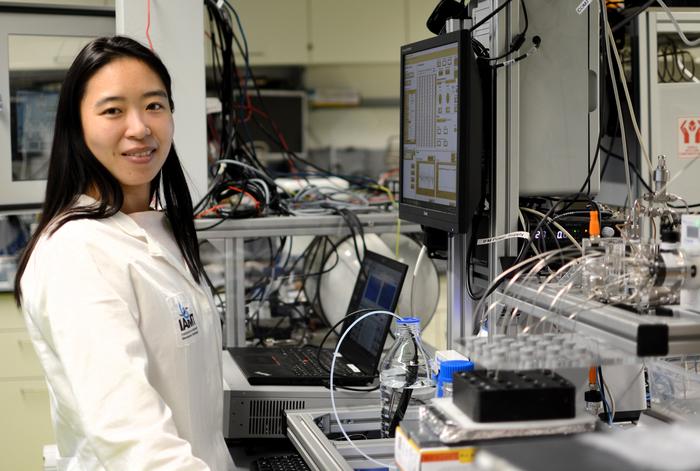Water scarcity continues to be an alarming global crisis affecting millions of lives. The quest for clean and safe drinking water pushes researchers to delve into innovative purification technologies, unveiling methods capable of combating pollutants that pose serious threats to both public health and the environment. Among these pollutants are micropollutants, notably endocrine-disrupting substances such as steroid hormones found in pharmaceuticals, which have sparked extensive scientific inquiry. Researchers at the Karlsruhe Institute of Technology (KIT) are making significant strides in their investigation into these harmful compounds, focusing on advanced electrochemical oxidation techniques for their degradation.
Electrochemical oxidation (EO) is emerging as a powerful method for the treatment of contaminated water. This approach utilizes an electrochemical cell that comprises an anode and a cathode linked to a stable external power source. When an electrical current passes through the cell, complex chemical reactions unfold at the anode that facilitate the breakdown of organic micropollutants. The efficacy of EO can be notably enhanced when implemented in electrochemical membrane reactors (EMR), which maximize surface area and improve mass transfer efficiency between the electrodes and the water.
The importance of addressing micropollutants could not be overstated, especially when considering the pervasiveness of steroid hormones in our water systems. Traditional water treatment methods often fail to detect or adequately remove these contaminants, leaving an unsettling risk for ecosystems and human health alike. Researchers at KIT’s Institute for Advanced Membrane Technology (IAMT), including Dr. Siqi Liu and Professor Andrea I. Schäfer, are at the forefront of this research. Their groundbreaking findings illuminate the mechanisms by which carbon nanotube membranes can be employed within EMRs to effectively eliminate these detrimental substances from water.
Carbon nanotubes (CNTs) exhibit unique physical and chemical properties that render them ideal candidates for use in advanced filtration systems. Their minuscule diameter grants them a remarkably high surface area, directly enhancing their capacity to adsorb organic compounds. Moreover, the exceptional electrical conductivity characteristic of CNTs facilitates efficient electron transfer during electrochemical processes. This allows for a swift degradation of harmful micropollutants present in wastewater – a feature that traditional filtration methods sorely lack.
In an in-depth study conducted in collaboration with leading scientists from the University of California, Los Angeles, and Hebrew University of Jerusalem, researchers employed advanced analytical methods to expound on the interactions occurring within the EMR. They focused on the complex interplay between adsorption and desorption of steroid hormones and the subsequent electrochemical reactions that led to their degradation. The results were illuminating: the pre-adsorption of the hormones on the surface of carbon nanotubes did not hinder their degradation rates, highlighting the rapid mass transfer capabilities present in these innovative systems.
The findings from this rigorous investigation have profound implications for future water purification technologies. By elucidating the factors that limit the efficient degradation of these harmful substances under varying conditions, the study provides a potential framework for optimizing electrochemical strategies aimed at micropollutant removal. Such advancements could lead to the development of more effective water treatment solutions, catering to the growing need for clean and safe drinking water in an increasingly polluted world.
The collaborative efforts encapsulated in this research are, undeniably, a testament to the power of interdisciplinary approaches in tackling complex environmental issues. By blending expertise in material science, chemistry, and engineering, the researchers are paving the way for novel insights that can transform our understanding of micropollutants and catalyze innovative solutions tailored to preserve our precious water resources.
As the world grapples with the emerging consequences of water pollution, research of this caliber shines a light on the pathway forward. The innovative strategies explored within these scientific investigations not only promise to enhance our current water treatment methodologies but also inspire future explorations of sustainable technologies that can uphold environmental integrity.
The urgency to develop and implement effective water purification technologies is more pronounced than ever. With rising pollution levels threatening both health and ecological balance, the prospect of employing electrochemical oxidation alongside carbon nanotube membranes is a beacon of hope in combatting some of the most challenging contaminants existing in our water supplies today. As this research progresses, it could ultimately redefine the landscape of water treatment technology, bringing us closer to achieving the vital objective of ensuring safe drinking water for all.
In conclusion, the work of the KIT researchers not only tackles a pressing issue but also exemplifies the intersection of science and technology in driving forward solutions that address global challenges. The progressive nature of their research embodies a collective goal: a world where clean water is not a luxury but a standard reality, echoing a sustainable future for generations to come.
Subject of Research: People
Article Title: Differentiation of adsorption and degradation in steroid hormone micropollutants removal using electrochemical carbon nanotube membrane.
News Publication Date: 4-Nov-2024
Web References: https://doi.org/10.1038/s41467-024-52730-7
References: Nature Communications, 2024.
Image Credits: IAMT, KIT
Keywords
Electrochemical Oxidation, Micropollutants, Carbon Nanotubes, Water Treatment, Endocrine Disruptors, Membrane Technology, Environmental Science, Purification Methods





